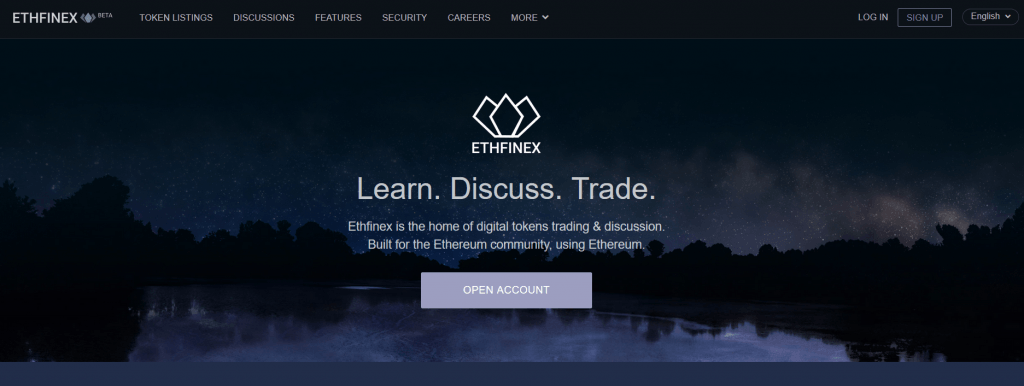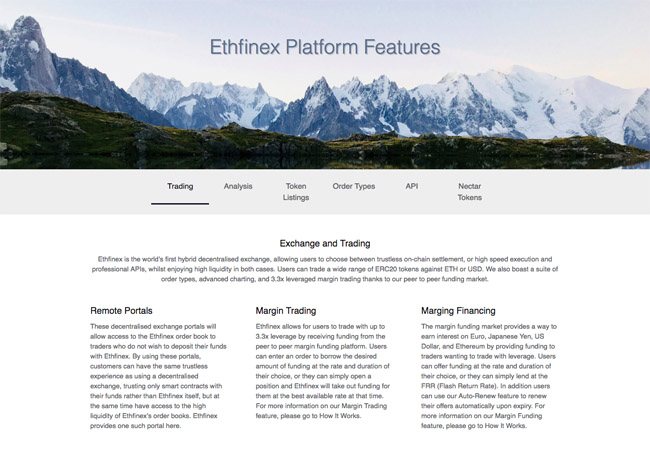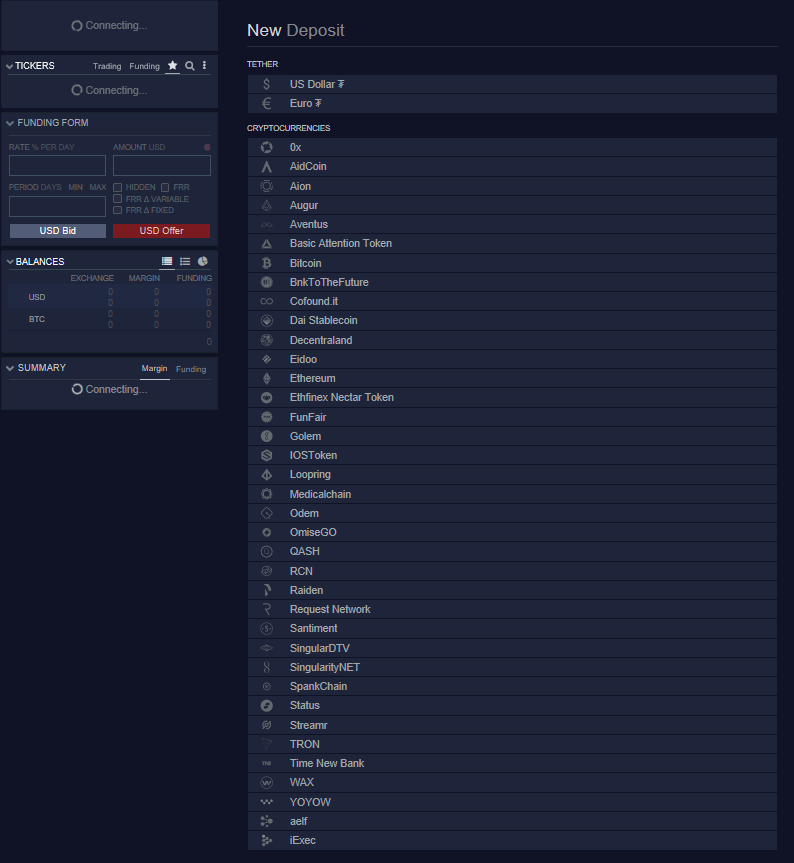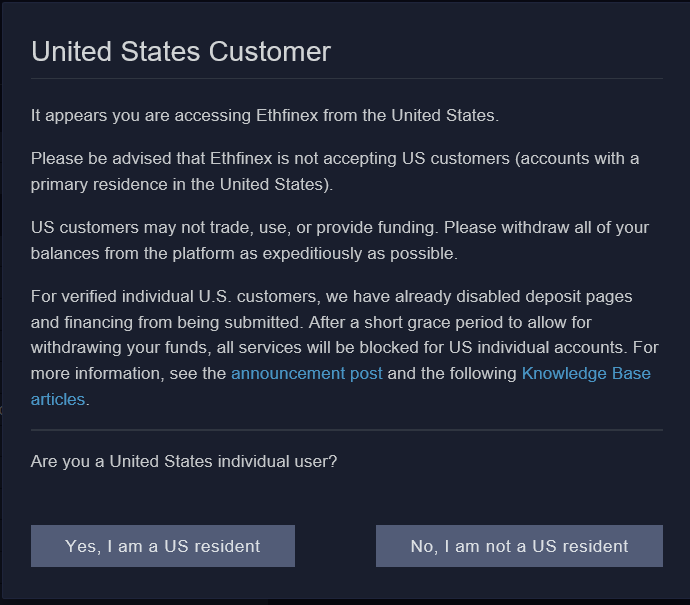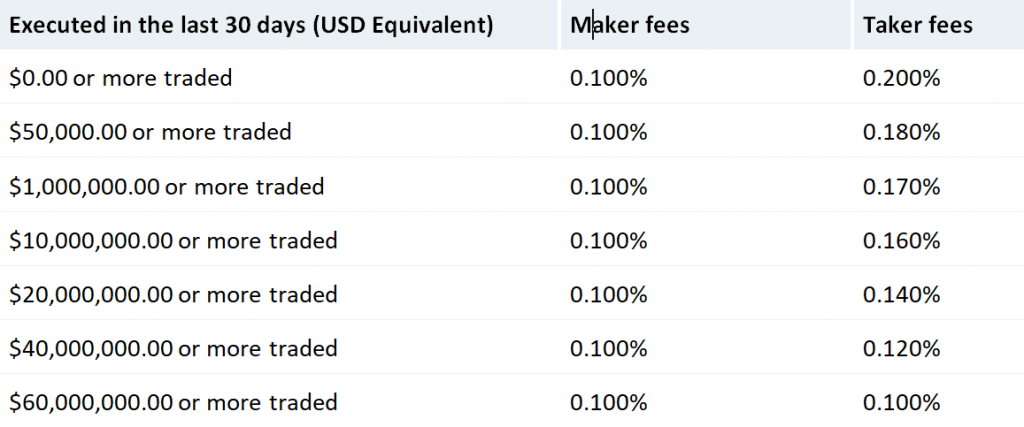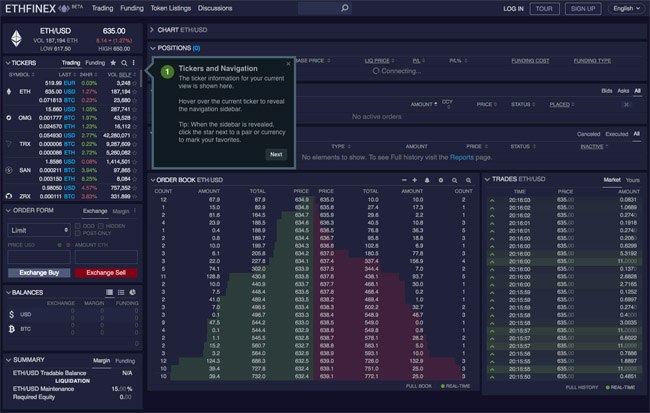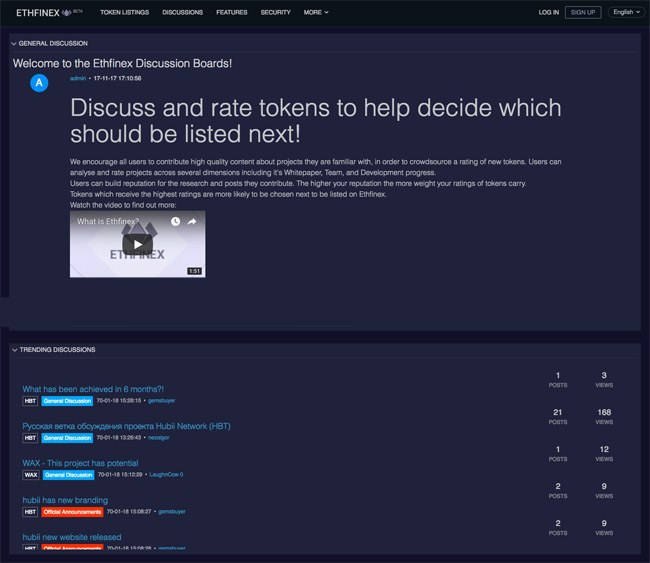Ethfinex is an exciting new decentralized exchange that focuses on Ethereum based ERC-20 tokens. It’s ultimate goal is to be the hub for the extended Ethereum community, providing not only trading, but also communications and the ability for Ethereum developers, traders and enthusiasts to come together for discussions and crowdsourcing needs. It’s a sister site to Bitfinex, and as such it shares similar objectives. It is also designed for intermediate and advanced trades, so this should be kept in mind when opening an Ethfinex trading account.
Ethfinex Overview
Ethfinex was designed to be a cryptocurrency exchange with a focus on Ethereum ERC-20 tokens and the Ethereum network as a whole. It has as one of its goals to become a hub of community for Ethereum enthusiasts, traders, holders and developers around the world. In addition to the decentralized exchange for trading ERC-20 tokens, you will also find a discussion forum, blog, access to ICOs and a host of other information.
As the name indicates, Ethfinex is connected to Bitfinex and is part of the growing number of companies and projects that trade their origin back to the popular Bitfinex platform, such as the Tether platform.
While Bitfinex is located in Hong Kong, Ethfinex is a registered company in the British Virgin Islands, and operates under the laws of that jurisdiction.
Trading on Ethfinex commenced on December 29, 2017 for existing Bitfinex users, with registration opening to the general public on January 15, 2018. Even though the platform states it seeks to create a global community of Ethereum users, it is not available to U.S. residents and citizens. And while trading is taking place on the platform it is still in its Beta development phase, with new features still being rolled out as completed.
One of the strengths of the platform is that in addition to trading of ERC-20 tokens, it also allows for margin trading, a peer-to-peer funding market, and an active community forum for discussions of ERC-20 projects.
During the first month of trading, Ethfinex saw fairly substantial trading volume, especially ETH/USD. This was likely due to new users staking initial deposits as the largest pair being traded now is OMG/USD and as of April 2018 the exchange is seeing roughly $40 million in total daily trading volume, ranking 31st in exchanges on Coinmarketcap.com.
Prominent Ethfinex Features
- Functionality – The Ethfinex platform was obviously built around the Bitfinex platform which is a good thing as it is well designed, very user friendly and has a modern, clean design. The platform allows for a high degree of customization, and is very comprehensive in its features and functions. The downside is that currently it is only available as a web based app, although one can guess that Ethfinex has plans to roll out a desktop and mobile version once they are out of beta.
- Security – Security has been solid from day 1 at Ethfinex as they had the benefit of learning from the prior mistakes made at Bitfinex. The platform keeps 99.5% of all crypto assets in inaccessible offline cold storage, which also requires the manual intervention of several management personnel to unlock. Customer accounts are subject to a number of automated verification tools that monitor account changes, including logins, settings changes, and of course deposits and withdrawals. Customers are encouraged to make use of 2-factor authentication immediately after account creation, and PGP encryption is also in use.
- Customer Support – Ah, customer support. It’s always a tricky subject with cryptocurrency exchanges, but so far there haven’t been any huge complaints about the Ethfinex customer service. They utilize the same model as other crypto exchanges, with an extensive knowledgebase being the first line of support, followed by support center tickets. There are rumors of online chat coming, but that’s currently not an option. Support is also offered via active Twitter and Telegram communities.
- Trading Options – Ethfinex has a wide range of order types available, including the basic market, limit and stop loss orders. Additionally, traders can use more advanced order types such as fill or kill, one cancel other, trailing stops and iceberg. And for those that need more excitement in the already volatile ‘cryptoverse’, Ethfinex offers margin trading with leverage up to 3.3x through the peer-to-peer lending platform.
- Hybrid Decentralisation – Ethfinex operates a pioneering hybrid decentralized exchange system, this allows its users to choose between trustless on-chain settlement, or high speed execution and professional APIs. By using decentralized remote portals, users can access the Ethfinex order book without actually having to deposit their funds with Ethfinex. These portals allow customers to utilize trustless smart contracts when trading while still having access to the high liquidity of Ethfinex’s order books.
Supported Currencies
If you include Tether, there are now 39 traded pairs available on the platform (12 were added April 7, 2018). Ethfinex additionally provides support for US Dollar (USD) fiat deposits and trading. Some of the supported currencies currently include:
Traders can make deposits via Bitcoin, or in U.S. dollars via bank transfers and wires. The exchange also supports both USDT and EURT. And as we’ve seen with the addition of 12 new ERC-20 coins at the beginning of April 2018, the team at Ethfinex is actively working to add support for new coins. This should guarantee regular additions of new coins. If you want to be more pro-active, there is also a community vote that gives traders a say in which coins should be added to the platform next.
In addition to the Ethereum based coins added for trading, Ethfinex also has its own coin called the Nectar token (NEC). This token has never had an ICO, but is instead given out to traders based on their trading volume over a given time period. Nectar tokens can be used to claim loyalty bonuses from the monthly exchange fees, and also give votes regarding the future governance of Ethfinex.
How to Sign Up to Ethfinex
Immediately upon clicking the “Open Account” button on the Ethfinex homepage you’ll be confronted with a disclaimer telling you the service is meant for more experienced traders, and asking you to confirm that you understand trading at Ethfinex isn’t designed for beginners. The terms and conditions are explained, along with one very welcome change. Up until April 7, 2018 you were required to have $10,000 or more deposited at Ethfinex to access their features and services, including trading, but as of that date the new minimum deposit requirement is just $1,000, making the platform much more accessible. Apparently the minimum deposit reduction is exactly to prepare for a large influx of new users. The bad news is that the Know-Your Customer and Anti-Money Laundering verification process is still being quoted at 6-8 weeks to complete.
You’ll need to tick off boxes to agree to all the terms and conditions, after which you can finally move on to creating an account.
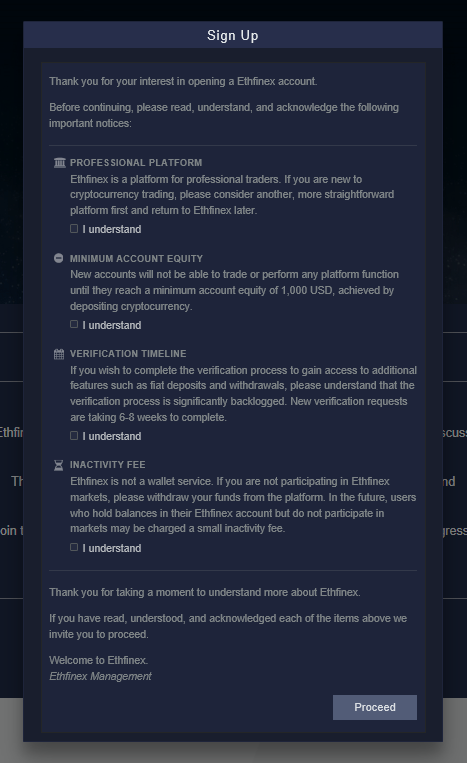
Create an Ethfinex Account
Like most of the cryptocurrency exchanges you can easily open an account at Ethfinex by entering your email address and a password, but Ethfinex also requires a unique username, your current timezone, and the completion of a captcha.
If you’re registering with an email that already has a Bitfinex account you’ll also be asked if you want to link the Ethfinex and Bitfinex accounts. If you agree to this feature you’ll receive an email with a link that will allow you to sing into your Bitfinex account and link it with your Ethfinex account.
If you create the account from a U.S. IP address you’ll receive the following pop-up dialogue:
How to Make a Deposit at Ethfinex
Once you’re registered and logged in (assuming you aren’t a U.S. resident) you can make a deposit to fund your account and begin trading. The “Deposit” link in the upper right corner will take you to the deposit page, and it’s here you can choose from the list of nearly 40 ERC-20 tokens, U.S. dollar Tether or Euro Tether to make a deposit.
Once your account is funded you’re all ready to begin trading. Clicking on the “Trading” button will take you to the available pairs where you can decide on the price, quantity and order type and place a trade.
Ethfinex Fees
Ethfinex has a flat 0.10% maker fee regardless of monthly trade volume. The maker fee is paid when you add liquidity to the order book by placing a limit order, either below the current price quote when buying or above the current price quote when selling. Taker fees work on a sliding scale that starts at 0.2% and declines to as low as 0.1% for those trading $60 million a month. The taker fees are paid by those who remove order book liquidity when they fill an order that’s already in the order book.
All large cryptocurrency deposits are free at Ethfinex, but there is a small fee for any deposits that are smaller than $1,000. This fee is charged to discourage clients from making multiple small deposits as it puts strain and unnecessary transactions on the Ethereum network, slowing down transactions, including client withdrawals. For this reason Ethfinex recommends batching smaller deposits together into one larger deposit. There are also withdrawal fees, which vary depending on the cryptocurrency being withdrawn. You can see all deposit and withdrawal fees here.
Ethfinex also claims that deposits made in error can sometimes be recovered, although there is no guarantee of this. If you report a deposit error the team will attempt to recover the deposit, and there will be a $150 fee charged to your account.
Is Ethfinex Safe?
Ethfinex has developed their security protocols around the best practices that have evolved at Bitfinex over the years. Bitfinex has been the victim of several hacks over the years, and while this was troubling at the time, it only made the exchange stronger. Ethfinex uses a cold storage system for crypto assets, and only 0.5% are ever accessible via the online “hot” wallets. To increase security further, the cold storage wallets are not connected to the platform servers, and to access the cold storage funds several of the Ethfinex management team must sign off.
Ethfinex also takes the security of client accounts very seriously, and employs a number of methods to secure these accounts as fully as possible. You’ll of course find that 2-factor authentication is a standard, as is withdrawal protections that require verifications. All email correspondence is encrypted with OpenPGP, and advanced API key permissions are standard as well. Finally, Ethfinex employs several software based verification tools that constantly monitor account activities and flag any suspicious behaviors.
Ethfinex is a hybrid decentralized exchange, which does make it different in some ways from traditional exchanges like Coinbase and Kraken. Users are in control of their own security through the Ethfinex Portal, and it is possible to view the full Ethfinex order book and make a trade without depositing funds into the Ethfinex account.
These trades are completed via smart contracts on the Ethereum blockchain, utilizing the 0x protocol, but future plans are to allow any decentralized exchange protocol to connect with Ethfinex. When using this feature customers should be aware that there is a minimum trade size of $200.
Trading on Ethfinex
A mentioned at the start of this guide, Ethfinex is not meant for beginning traders, but has rather been designed to accommodate the intermediate and advanced trader. For this reason, the platform allows for a wide variety of trade types, giving traders full control and flexibility. Customers are able to place all the following trade types on Ethfinex:
- Market
- Limit
- Stop
- Trailing stop
- Fill or kill
- One cancels other (OCO)
- Post-only limit order
- Hidden order
- Algorithmic Orders
By operating as a hybrid decentralized exchange, Ethfinex exposes its customers to both high trade volumes and liquidity. The order counts and bid/ask is resolved in real time, providing flexibility to traders as it allows them to choose the most opportune time to place their orders. This is a big improvement over centralized exchanges.
To give traders even more flexibility, Ethfinex allows for the use of margin in trades with leverage of up to 3.3x. This leverage is obtained through funding from the peer-to-peer marketplace. Traders have the choice of allowing Ethfinex to borrow funding for them at the best available rate, or they can manually choose a funding rate and duration by manually entering the marketplace. This use of margin is excellent for experienced aggressive traders, but may be too much for those with less experience. Caution should be used when considering the use of leverage in an already volatile market like cryptocurrencies.
Besides providing traders with margin requirements, the funding market also provides lending clients with a way to earn interest on their Ethereum and USD deposits. Those willing to lend can automate the process by offering to lend at the preferred rate and duration, but there is also an option to end at the Flash Return Rate (FRR). It is also possible to auto-renew offers immediately after they expire, thus ensuring that funds don’t sit idle.
There are of course additional fees incurred by the use of margin and margin funding. This includes a charge on fees collected by Margin Funding Providers of 15.0% (of the fees generated by active margin funding contracts). Also the charge on fees collected by Margin Funding Providers, when opened by a hidden offer is 18.0% (of the fees generated by active margin funding contracts).
The Ethfinex Community
One of the stated goals of Ethfinex is the creation of a community of Ethereum developers, traders and enthusiasts. The site is a hub for sharing ideas and communicating and includes articles and analysis, as well as discussions about upcoming token releases or tradable tokens. This community provides a way for investors, traders and others to come together and discuss their analysis and opinions, generating a healthy debate about all types of ERC-20 tokens.
The community will also provide for crowd sourced ratings of tokens, which is based on the collaboration of the community. The ratings will take into account various factors regarding each project, such as the whitepaper and project concept to help users understand the purpose of each project. Each project which is releasing an ERC-20 token will also be allowed to set up their own dedicated discussion board, and create their own on-site community. The real benefits of this community will be most apparent when Ethfinex provides access to crowdsale ICOs on their platform. Of course there does exist the possibility of such a crowdsourced system being gamed until it reaches a critical mass, so this should also be kept in mind when using the Ethfinex discussion feature.
In Conclusion
The first thing I want you to keep in mind is that Ethfinex is still very much in its beta stage, so new developments should be coming rapidly, and could change the platform dramatically in the coming months. There has also been some controversy regarding the parent company Bitfinex and the Tether stablecoin that they create and promote. And those who are security conscious will also want to remind themselves that Bitfinex has been hacked in the past, and Ethfinex is following the same security guidelines and protocols.
That aside, the concept of a decentralized exchange dedicated solely to ERC-20 tokens and the Ethereum blockchain seems like a winner. The fact that it runs on the 0x protocol makes it even better as it brings trustless exchange, smart contracts, speed, and increased efficiencies.
The concept is great, but because Ethfinex is so new it certainly needs more time to be proven. And it would be immeasurably helpful if the whole Bitfinex/Tether issue was cleared up and the company embraced an increased level of transparency. At this point we remain cautiously optimistic about the future of Ethfinex.
Ethfinex Pros
- Extensive trading options, including 3.3x leverage
- A community focused hub for ERC-20 tokens and the Ethereum network
- High liquidity thanks to the use of 0x and smart contracts
- Peer-to-peer marketplace offers the opportunity to generate interest on idle capital
- Ease of access to Ethereum based crowdsales
Ethfinex Cons
- Still in Beta
- No Bitcoin or non ERC-20 Tokens
- Minimum equity requirements
- US Residents prohibited from trading
- Bitfinex/Tether controversy and lack of transparency
